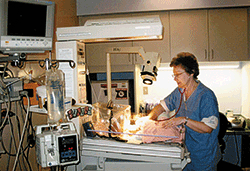Managing bleeds has been a part of life for Judy Ann Pegg-Schunck, RN, 64, since her earliest memory. “When I was about 1, I fell and hit my frenulum, the piece of gum between the lip and teeth, and that really bled,” explains the resident of China Township, Michigan, about an hour’s drive from Detroit. “I remember being in a room surrounded by doctors and nurses.”
Pegg-Schunck was initially diagnosed with hemophilia B, but that was incorrect. “They didn’t know as much back then,” she says. “I finally got the real diagnosis when I delivered my son.” Her true condition—factor X (FX) deficiency—is even less common than hemophilia A or B. FX deficiency is incredibly rare, affecting between 1 in 500,000 and 1 in 1 million people.
In contrast, Teresa Pavlak, of Wyoming, Michigan, a suburb of Grand Rapids, was diagnosed with FX deficiency shortly after she was born. “When they poked the needle in my heel, I wouldn’t stop bleeding,” says Pavlak, now 29.
Pavlak was 8 when she first experienced bleeding in her brain from a sledding accident. “I accidentally let go and smashed my head,” she says. Later bleeds happened from falling off a slide in elementary school, and bumping heads with a friend. Her father became a sentinel, watching over her. “He had to be outdoors when we’d go out to play so he could see me.”

Judy Ann Pegg-Schunck
What is FX Deficiency?
FX deficiency is a bleeding disorder affecting one of the proteins in the blood involved in the coagulation cascade, the chain reaction that causes blood to clot. It is also sometimes called Stuart-Prower factor deficiency, after the last names of the first two patients identified with it.
The lower a person’s level of FX, the higher their risk of bleeding. Your FX level is measured as a percentage of normal levels. A patient with levels less than 5% has the most dramatic bleeding manifestations, according to Paula L. Bockenstedt, MD, associate professor of internal medicine at University of Michigan Health System in Ann Arbor. Pegg-Schunck’s levels are between 1% and 3%. Pavlak’s body produces no FX.
FX deficiency is inherited as an autosomal recessive disorder, meaning that each parent must pass on a defective gene for a child to be affected, says Jim Munn, RN, MS, program and nurse coordinator at the Hemophilia and Coagulation Disorders Program at University of Michigan Health System. There is also a rare acquired form of FX deficiency experienced by patients on certain blooding-thinning drugs, such as Coumadin® (warfarin). The acquired form is less severe than the inherited form.

Teresa Pavlak
Symptoms of FX deficiency are similar to those of hemophilia A and B: easy bruising, nosebleeds, bleeding from the gums and joint bleeds. Women can experience menorrhagia (heavy periods). The most serious complication is intracranial hemorrhage, or bleeding inside the brain. Pavlak has experienced several head bleeds in her lifetime and deals with very heavy periods. Pegg-Schunck’s early symptoms included frequent nosebleeds and bruising, as well as swollen limbs. “I remember being 5 or 6 years old and my mom carrying me because the pain was so bad.” She also had heavy periods as a teenager.
To confirm a diagnosis of FX deficiency, blood tests are performed. They assess the time it takes a fibrin clot to form and the presence of clotting factors. For the first measure, two tests are needed: prothrombin time (PT) and partial thromboplastin time (PTT). “In the patient with FX deficiency, both of those numbers will be prolonged,” Bockenstedt says. Depending on the results of the tests, other family members may also need to be tested.
Treatments Then and Now
Half a century ago, managing a minor bleed was typically done at home. “My mom would wet a tea bag and hold it down, and that would help,” says Pegg-Schunck, recalling the treatment for a lost tooth. “As I look back, though, it wasn’t very controlled.”

(second from right) Judy Ann Pegg-Schunck
with her family.
During grade school, Pegg-Schunck received transfusions of whole blood to treat bleeding episodes. In her teenage years, she started receiving fresh frozen plasma. Historically, fresh frozen plasma was used in factor replacement, but there were several problems, says Bockenstedt. The volume that needs to be administered at any time point may be too great. That is, it may take too long, or the patient may not be able to tolerate the extra volume given. The second issue involves potential allergens in the plasma. “You’re subjecting the individual to other plasma proteins, so there’s a greater risk of allergic reaction,” she says. And finally, it requires the patient to go to a hospital or clinic for replacement. This is inconvenient for patients and can lead to delays in getting timely treatment.
Since 2001, when she started seeing Bockenstedt, Pegg-Schunck has been infusing herself prophylactically with Bebulin®, a prothrombin complex concentrate (PCC) that includes FX. It’s made a world of difference, she says. “I’ve had much fewer bleeds,” Pegg-Schunck states. Pavlak also self-infuses with Bebulin once or twice weekly.

Pegg-Schunck devoted most of her
nursing career to premature babies.
But PCCs have their downsides, Munn says. The concentrations of FX included in them can vary. Plus, they contain factors that aren’t needed, namely factors II, VII and IX. “What you’re trying to do is balance giving enough FX to stop bleeding but not giving more of the other proteins, which patients have normal levels of and that can cause clotting,” he explains. In other words, medical teams want to avoid creating the opposite problem: unwanted clotting.
Pegg-Schunck self-infuses at home twice a week, on Mondays and Thursdays. However, she still gets bleeds from time to time. “Mostly mine are muscle bleeds, which are very painful,” she says. When Pegg-Schunck starts to feel this pain, she self-infuses again, ideally right away or within a couple of hours.
Last year, there was a significant development in FX deficiency treatment: a factor concentrate called Coagadex®. Manufactured by Bio Products Laboratory, Ltd., it was approved by the FDA in October 2015. It is the only FX concentrate available in the US that is purely FX and nothing else, Munn says. Currently, it’s licensed for on-demand treatment of bleeds and to manage bleeding before, during and after surgeries—but not yet for prophylaxis. Still, Coagadex is a valuable tool to have, says Bockenstedt. “We now have a more specific product for patients who really require just FX replacement, which will hopefully reduce adverse reactions,” she says.
In the fall, Pavlak was treated with Coagadex for the first time. “I have another mutation that puts me at higher risk for developing a blood clot, which is why the new FX product is amazing,” she says. “We’re hoping it’ll make a difference in my treatment.”

Pavlak and her husband, Jared,
who advocates for her healthcare needs.
Building a Life
Having FX deficiency has had a tremendous impact on many aspects of Pegg-Schunck’s life, including her career choice. “As a child, I was always a patient,” she explains. “I wanted to be on the other side, so I became a nurse.” Most of her career was in a special care nursery. “I just loved the preemies and the newborn nursery,” she says.
When it came to having her own children, however, Pegg-Schunck and her husband, Dan, didn’t know if it would be possible given her health challenges. Fortunately, she was able to become pregnant, though she faced some complications along the way.
“I first bled at 26 weeks,” she says. Fresh frozen plasma stopped the bleeding. “Then I was good until 37 weeks when I woke up in the middle of the night and I was really bleeding.” She was flown by helicopter to University of Michigan’s hospital, where her son Danny was born. Danny has no signs of a bleeding disorder, but is a carrier because of how the deficiency is transmitted. The couple’s adopted daughter, Hannah Mary, does not have a bleeding disorder.
At age 55, Pegg-Schunck retired from nursing because the pain from her bleeding disorder prevented her from working long shifts. Now, she visits family in Florida once or twice each year, and enjoys time with her children and grandchild. She travels to the University of Michigan once a year to check in with her medical team, including Bockenstedt.
“I never know how I’m going to feel day to day,” she says. “But when I do feel good, I feel good.”
Day By Day
Pavlak deals with the lasting effects of the childhood brain bleeds. “I have epilepsy due to the head bleeds,” she says, As a result, she is prohibited from driving. “Getting someone to drive me to all my appointments is sometimes really difficult,” says Pavlak.
For medical care, Pavlak travels an hour away to the West Michigan Cancer Center & Institute for Blood Disorders in Kalamazoo. At a minimum, she goes once a year for a comprehensive clinic visit. Currently, she’s dealing with prolonged menstrual cycles and losing a lot of blood, so she’s been to the clinic more frequently. Because of the high risk of hemorrhaging, her physicians recommend that she avoid pregnancy.
Pavlak tries to stay healthy to the best of her ability. “I have to be really careful with riding a bike or working out,” she notes. “If I overdo it, that causes a bleed.” Her husband, Jared, provides critical support. “He’s been an advocate for me when I’ve been unable to do it.”
The Power of Connection
Pavlak was a pre-teen when she and Pegg-Schunck connected through a bleeding disorders directory and became pen pals. “After writing for a few years, we met, and it was wonderful,” Pegg-Schunck remembers. Pavlak adds, “We talked about the struggles, what medications we use and things we deal with on a daily basis.”
Both women have also benefited from the support of their local chapter, the Hemophilia Foundation of Michigan (HFM) in Ypsilanti. Pegg-Schunck has been an enthusiastic attendee of the chapter’s SpringFest for families with bleeding disorders. “I met one of my best friends there,” she says.
And Pavlak has fond memories of an HFM summer camp she attended as a youngster. “I made a ton of friends there and I still talk to them,” she says.
Pegg-Schunck and Pavlak are part of a small number of individuals with FX deficiency. Still, they play a large role in each other’s support system, and in the care and advancing treatment for people in the bleeding disorders community.

